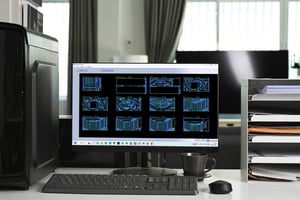Before the era of computers, programming machines for sheet or roll-based manufacturing was a...
DXF nest splitting: One complication that manufacturers don’t need

When it comes to creating tooled ‘component’ files prior to nesting, the CAM department may often receive a single DXF file that contains multiple geometries for all the plies required for a given composite part. This then needs to be manually processed, whereby the operator will need to save each ply as a separate DXF file, prior to them being imported and tooled. Furthermore, there may be additional information stored as text on a layer within the file. This might contain information such as the ply name, material or orientations allowed. If an operator is manually splitting the geometry, they would then have to also manually process any text data, leaving open a significant possibility for error.
For subcontractors working with multiple customers that supply DXF nests, the problem can be even more complex. Different customers can provide DXF nests that have different formats, such as layers that need to be stripped out or specified as marking layers. This brings even more possibility for errors, as the user must remember how to split each nest differently.
When combined, these issues can turn what is a minor problem into a time-consuming headache that has the potential for introducing errors.
Martin Bailey, MD of JETCAM commented; “I recall performing a demo of our automation to a customer where, as part of the normal demo process, I opened a DXF nest and split it, which takes less than a second. At this point, the programmer slumped back in his chair, let out a big sigh and said, ‘I just spent a month doing that’.”
While outputting a DXF nest during the design/CAD process might appear to make sense and may simply be more convenient at that stage, it causes complications and inefficiencies further down the manufacturing line. It also may be unnecessary. If, for example, the reason for producing a DXF nest is to keep all the same revisions of a part together, why not investigate whether revision data can be associated with each ply at the CAD stage? This data can then follow through to CAM and nesting, meaning that if one ply changes, you only update that ply, rather than creating a new DXF nest of all plies.
JETCAM CAD Splitter: The Optimal Solution
Setting it up
When first started, the CAD Splitter requires a default profile to be created. The user specifies data such as tolerances to automatically join nodes, whether borders should be removed, and how to handle text. More complex profile rules can also be defined, such as deleting or renaming layers, or specifying that they contain marking data. Text within identified geometry can also be used for the filename, and the original DXF name can be used as the resulting assembly name.
Users can create unlimited profiles, ensuring that each customer’s unique requirements do not have to be re-entered each time. A key feature is the ability to specify an external processor, which will run automatically after the user clicks Save and Exit. Saving performs two actions – creating the individual DXFs and a CSV file containing one row per DXF. This is where the importance of having the option of an external processor comes in; If, for example the DXF nest contains additional text information per ply, an external processor can extract this information and append it to the CSV file, making it immediately ready for processing within JETCAM Orders Controller or CrossTrack.
The workflow process
Once configured, the CAD Splitter takes seconds and only a few mouse clicks to process even complex DXF nests. The user clicks ‘Add Files,’ followed by ‘Expand all.’ All files are immediately split. Clicking ‘Save and Exit’ generates the DXFs and CSV file. If an external processor is in use, all the required data for automated CAD import could be immediately available. If JOC or CrossTrack are set up for full automation, they would instantly grab the CSV, import each ply, apply cutting technology for one or more machines, and create an assembly.
CAD Splitter is free for all customers under maintenance.
Originally, the CAD Splitter was included within JETCAM Orders Controller but is now available free of charge to all JETCAM Expert users with a current maintenance contract. Available from the Download Wizard, it can be installed in under 60 seconds, with configuration taking a similar time. Users can then immediately split DXFs and start processing the resulting files. No software license or dongle is required – it just needs access to your JETCAM Expert installation folder. Tying the CAD Splitter with any of JETCAM Expert’s, JOC’s or CrossTrack’s automation means that you can move from DXF nest to NC code in a matter of minutes, with only a few clicks of the mouse and little technical knowledge.
Do you need to create a DXF nest in the first place?
If your company has historically created DXF nest ‘because it’s always been done that way’, it may be worth investigating whether your CAD software can perform the splitting for you. Both Dassault CATIA v5/3DX and Siemens NX can export data to JETCAM, with DXF plies being accompanied by an XML or CSV file containing all the additional information required to perform CAD import. So, although you may have inherited a specific way of working, it could be that you already have the ability to bypass the DXF nest creation and subsequent splitting process.
Summary
Manually splitting DXFs is an archaic process – especially when the JETCAM CAD Splitter can complete the process reliably in seconds. If your JETCAM license is under maintenance, make sure that you have downloaded and installed the CAD Splitter to ensure that it’s there when you need it. If your maintenance has expired, take a moment to explore the additional companion apps and other benefits of a current maintenance contract. Remember, you can also save a further 5% every year with maintenance autorenew.
%20(Custom).jpg?width=1000&height=252&name=JETCAM%20logo%20(glossy%20effect)%20(Custom).jpg)
.png?height=200&name=640px-Telex_Ticker_Tape_(11438441186).png)

